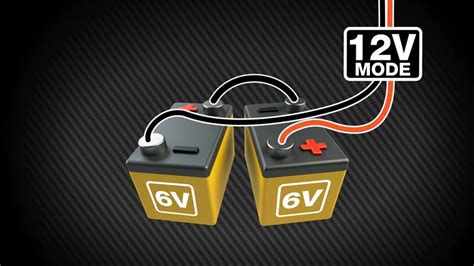How To Charge 6 Volt Battery
Ronan Farrow
Mar 23, 2025 · 3 min read

Table of Contents
How to Charge a 6-Volt Battery: A Comprehensive Guide
Charging a 6-volt battery might seem straightforward, but using the wrong method can damage your battery or even create a safety hazard. This guide provides a comprehensive walkthrough on how to correctly charge a 6-volt battery, regardless of its type (lead-acid, NiCd, or NiMH). We'll cover everything from choosing the right charger to understanding safety precautions.
Identifying Your 6-Volt Battery Type
Before you begin charging, it's crucial to identify the type of 6-volt battery you have. Different battery chemistries require different charging methods. The most common types are:
- Lead-Acid Batteries: These are the most prevalent type found in applications like golf carts, electric vehicles, and some older toys. They are relatively inexpensive but require careful charging to avoid damage.
- Nickel-Cadmium (NiCd) Batteries: These were once common but are now less prevalent due to environmental concerns. They have a "memory effect" that can reduce their capacity if not fully discharged before charging.
- Nickel-Metal Hydride (NiMH) Batteries: These are a more modern replacement for NiCd batteries and offer better performance and a longer lifespan. They are less susceptible to the memory effect.
The battery itself, its packaging, or the device it powers should indicate the battery type.
Choosing the Right Charger
The charger you select must be compatible with your battery type and voltage. Using an incompatible charger can lead to overheating, damage, or even explosion. Always use a charger specifically designed for the voltage and chemistry of your battery.
Key Considerations When Choosing a Charger:
- Voltage: Ensure the charger's output voltage precisely matches your battery's 6-volt rating.
- Battery Chemistry: The charger must be compatible with the chemistry of your battery (lead-acid, NiCd, or NiMH). Using a charger designed for lead-acid on a NiMH battery, for instance, will likely damage the battery.
- Charging Rate: Chargers often specify a charging rate (in amps). A slower charging rate is generally safer for the battery's longevity.
Charging Your 6-Volt Battery: A Step-by-Step Guide
Once you've identified your battery type and selected a compatible charger, follow these steps:
- Prepare the Battery: Clean the battery terminals with a wire brush to remove any corrosion.
- Connect the Charger: Connect the positive (+) terminal of the charger to the positive (+) terminal of the battery, and the negative (-) terminal of the charger to the negative (-) terminal of the battery. Ensure a secure connection to prevent sparking.
- Start the Charging Process: Turn on the charger and monitor the charging process. Some chargers will indicate the charging status (e.g., with LED lights).
- Monitor the Charging Process: Avoid leaving the battery unattended during charging, especially for the first charge cycle. Observe for any unusual signs like excessive heat or unusual smells.
- Complete the Charge Cycle: Allow the charger to complete the charging cycle according to its instructions. Do not interrupt the charging process unless necessary.
- Disconnect the Charger: Once the charging cycle is complete, disconnect the charger from the battery, starting with the negative (-) terminal first.
Safety Precautions:
- Ventilation: Charge the battery in a well-ventilated area to avoid the buildup of flammable gases.
- Protective Gear: Consider wearing safety glasses and gloves.
- Water and Flammable Materials: Keep water and flammable materials away from the charging area.
- Supervision: Never leave a charging battery unattended.
Maintaining Your 6-Volt Battery
Proper maintenance extends the lifespan of your battery. This includes:
- Regular Cleaning: Periodically clean the battery terminals to prevent corrosion.
- Proper Storage: If not in use, store the battery in a cool, dry place.
- Avoid Deep Discharges: Deep discharges shorten the battery's lifespan.
By following these steps and safety precautions, you can safely and effectively charge your 6-volt battery and ensure its optimal performance. Remember that consulting the manufacturer's instructions for both your battery and charger is always recommended.
Featured Posts
Also read the following articles
| Article Title | Date |
|---|---|
| How To Anchor A Gazebo To A Deck | Mar 23, 2025 |
| How Much Is Good Inside Membership | Mar 23, 2025 |
| How Much To Book Tevin Campbell | Mar 23, 2025 |
| How To Call A Mountain Lion | Mar 23, 2025 |
| How To Check Fuel Gauge On Boat | Mar 23, 2025 |
Latest Posts
-
How Long Does Probate Take In New Mexico
Apr 06, 2025
-
How Long Does Pressure Washing Take
Apr 06, 2025
-
How Long Does Polyurethane Smell
Apr 06, 2025
-
How Long Does Plaque Removal Take
Apr 06, 2025
-
How Long Does Pex Last In Concrete
Apr 06, 2025
Thank you for visiting our website which covers about How To Charge 6 Volt Battery . We hope the information provided has been useful to you. Feel free to contact us if you have any questions or need further assistance. See you next time and don't miss to bookmark.
